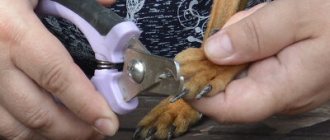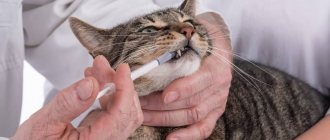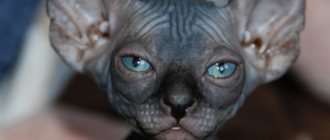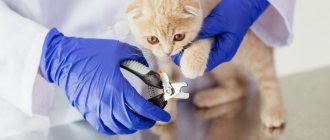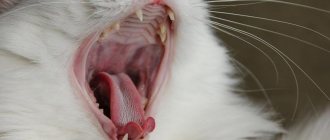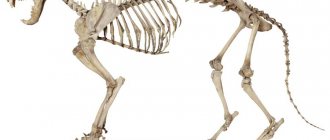What is the scientific name for a cat's whiskers?
Whiskers are the common name for the stiff hairs growing on the body of an animal. In fact, their scientific name is vibrissae, which comes from the Latin word vibro. Translated, it means “to waver” or “to wiggle.”
Indeed, the whiskers of cats, even in a calm state, tremble finely, that is, they vibrate. This is clearly noticeable if you look closely at your pet.
As a result of scientific research, it has been established that whiskers appeared on the body of the cat’s ancestors much earlier than they were overgrown with hair. In addition, observing the behavior of individuals helped to find out why the cat needed a mustache. Their presence is the main distinguishing feature of furry mammals.
Cat's whisker tongue
If the animal is in a calm state, then its whiskers are relaxed
An attentive owner may notice that the pet's whiskers are in different positions. If a cat's whiskers are pressed to its muzzle, it means that it is scared of something or is worried about something. This situation also indicates that the animal is angry and may show aggression.
If your pet's coarse hair points forward, it means he is curious or ready to interact. When he sleeps, his muzzle with mustache is relaxed. Knowing these subtleties will help you determine when you need to play with your cat or calm him down.
The structure and location of the whiskers in cats
Whiskers have been present on the faces of both male and female individuals since birth. The presence of this important organ does not depend on breed or genetics. But the difference in the length and thickness of the whiskers is associated with individual characteristics: breed, sex of the individual, conditions of detention. Knowing their structure and location will help you find out why a cat needs a mustache.
What are they made of?
The long hairs on the cat's face have an interesting structure. Each whisker is connected to a specific part of the brain and is responsible for the functioning of a specific system of the animal. This is why a cat needs whiskers: from the signals from the whiskers in the pet’s head, a complete picture of what is happening is formed. The hairs themselves grow up to 5-7 cm and consist of:
- nerve endings;
- skin glands and epidermis (the part invisible to the eye);
- the vibrissa itself.
The thickness of the hair is explained by the large number of nerve endings and sometimes depends on gender. Because of these endings, a tubercle appears at the very base of the hair.
Luxurious mustaches are found in individuals whose owners take care of a balanced diet rich in vitamins and microelements. On average, the length of the hairs in both directions is equal to the width of the mustachioed friend’s body.
Whiskers are not only on the face!
It is a mistake to assume that cats' whiskers are located only on their faces. Long, thickened hairs can be seen on different parts of the fluffy's body. They differ in quality from the whiskers on the muzzle. Vibrissae in cats grow:
- above the eyes;
- in the nose area;
- on the chin;
- in areas around the lip pads.
In addition to the listed places, long hairs are located on the front legs, but they are practically invisible there. A curious owner of a mustachioed pet can carefully examine the paw slightly above the area of the dewclaw (pad without a claw). This is where thickened hair grows. Why a cat needs whiskers on these parts of the body can be understood by observing the habits of a furry friend.
Why do cats and cats need whiskers?
It is clear that whiskers are not just hair on a pet’s body. They play an important role in the life of a furry individual.
Help in hunting
In ancient times it was believed that the length of the whiskers indicated hunting habits. The longer the hairs on the face, the better the cat catches rats and mice.
This fact has no scientific confirmation. But it is obvious that thick shoots are the pet’s main assistants during the hunt. Thanks to them, cats quickly pick up even small vibrations in the air that are created by a running rodent.
The furry hunter easily determines where the prey is and where it is moving. After the rodent is caught, the cat's antennae on its front legs help it retain its prey and control its behavior.
Orientation in space
Fluffy purrs are well known for their ability to move silently and deftly even in complete darkness. At such moments, it is not the eyes or ears that help the animal. The cat uses its whiskers to touch objects and avoid obstacles.
When touching surrounding things, the hairs vibrate, creating air movements. These signals are picked up by the whiskers and transmitted to a specific part of the brain. This is how the pet forms a three-dimensional picture of what surrounds it.
Tactile function
Touch is the main purpose of vibrissae. They help the fluffy one accurately determine the freshness of food and the safety of products. Before starting to eat, the cat will feel the food with its whiskers (sniffing movement) and only then begin to eat.
Signals in communication
It is easy to understand why a cat needs a mustache in those moments when the animal wants to communicate. If you look closely at your furry friend, you will notice the movement of the antennae. The vibrissae change direction in relation to the person or object of interest to the cat.
Whiskers pointed forward indicate the purr's desire to explore an object or desire to communicate with a living creature. Animals also collect antennae while playing or hunting.
Is it possible to remove cats' whiskers?
It often happens that cat owners, out of ignorance or “for the sake of beauty,” remove their pet’s whiskers. Sometimes a small child performs this action for fun, playing with the “kitty” and deciding to trim its mustache.
Doing this without a veterinarian’s prescription is strictly prohibited (the previous paragraph describes in detail what happens to a cat that has lost tactile hairs). Sometimes, due to any injuries or wounds, a cat’s whiskers are deliberately removed at a veterinary clinic.
. But they do this only if the vibrissae are located directly on the affected area. In other situations, veterinarians never trim a cat’s whiskers and do not recommend that its owners do so.
What happens if you cut off a cat's whiskers?
Since the whiskers are the vital organs of a pet, their loss leads to great difficulties. What happens if you trim a cat's whiskers?
Physiological or mental disorders
If a cat loses its tactile organ, then problems with its physiological and mental health are possible. It is known that without vibrissae the animal is poorly oriented in space. This occurs due to lack of information about the environment.
The cat begins to bump into objects and get stuck in passages that are too narrow. Cats cannot jump from one object to another. They are not able to fully hunt and obtain food. The loss of antennae is especially dangerous for yard representatives.
Often cats that are deprived of sensitivity become nervous and withdrawn. The mental state of the animals deteriorates sharply. They begin to avoid people around them, try to hide, or behave inappropriately.
Do cats grow whiskers?
Having found out why a cat needs a mustache, a person understands that cutting them is unacceptable. They are cut off only in case of injury or infection of nearby tissues. The procedure is carried out by a veterinarian to treat the problem area and prevent the development of complications.
Vibrissae are able to recover, but only if there is no damage to the hair follicle. Trimmed whiskers grow back in an average of 2-3 weeks, but sometimes the time period increases.
Problems with whiskers in cats
Having understood why a cat needs a mustache, the owner pays attention to their condition. Brittleness or loss of whiskers indicates problems with the pet's health and indicates a low quality of life.
They break down
The fragility of tactile hairs occurs due to an uncomfortable environment. For example, too dry indoor air negatively affects the condition of the organ and leads to its breakage. Brittleness also occurs due to insufficient consumption of fresh water.
You should not bathe your fluffy often. Chlorine in water and chemicals in pet shampoos negatively affect the elasticity of the whiskers.
Normalizing the humidity in the room, as well as constant access to clean drinking water, will help prevent further breakage. To wash your pets, you should use only high-quality products containing natural ingredients.
Fall out on their own
If brittle hairs indicate problems with the environment, then hair loss is a serious reason to think about your pet’s health. In some cases, hair loss indicates a food allergy.
Allergies often occur to whole milk or fish. In addition to the loss of whiskers, the cat begins to lose hair. Digestive problems arise, and tears begin to flow from the eyes of the allergic person. Such symptoms are a signal for the owner to review the animal’s diet. A visit to a veterinary clinic will help identify the allergen.
Loss of whiskers may also indicate vitamin deficiency. The lack of important microelements and vitamins in the diet and the monotony of the diet cause massive hair loss. Knowing why a cat needs a mustache, the owner must provide the animal with all the elements for the proper functioning of the body.
Another cause of loss is infection with intestinal parasites. Intoxication with their waste products affects the penetration of nutrients into the antennae. This provokes the death of the follicle and loss of the vibrissa.
Infection with skin fungus also occurs. Itchy areas appear around the whiskers, which peel off and gradually lose hair. All these problems require timely treatment prescribed by a veterinarian.
Grows slowly and poorly – or not at all
Slow hair growth indicates poor pet health. Short vibrissae indicate a serious lack of vitamins and microelements in the body.
Sometimes slow and poor growth of thick hairs is a sign of a metabolic disorder or a symptom of an endocrine disease. If the addition of a vitamin-mineral complex does not lead to an improvement in the quality of the whiskers, then consultation with a veterinarian is necessary.
Mustache problems
Whiskers are made up of keratin and structural components that form the basis of our hair and nails. Like regular hairs, a cat's whiskers periodically fall out and are replaced with new ones. Therefore, do not worry if you find your pet’s lost whisker on the carpet, this is normal. Moreover, according to an old belief, if you find a cat's whisker in the shed near your house and make a wish, it will definitely come true! In general, over the course of a cat’s entire life, you can collect a decent collection of its whiskers.
However, if too many whiskers fall out constantly, they grow poorly or do not grow at all, then it makes sense to consult a veterinarian, as this indicates an unbalanced diet, deficiency of vitamins and minerals.
Short, broken mustache, split ends may indicate the presence of some underlying disease, too rapid weight loss - it is better to do diagnostic tests.
Cats are curious animals. Having become interested in burning candles or the process of cooking, the cat first of all runs the risk of singeing its whiskers.
Kittens often have bitten whiskers as a result of playing with their peers, and sometimes the mother cat chews them too.
But the most common cause of mustache damage is scissors in the hands of children or an unsuccessful haircut.
Without its sensor whiskers, the animal becomes helpless, disoriented and simply miserable.
Damaged vibrissae grow back in a few weeks
, and with them coordination and a sense of confidence return to the cat.
With the help of whiskers, the animal receives information about obstacles on the way, about changes in air currents, and thus orients itself in space. Nerve impulses from the whiskers enter the brain along with information from other organs. Therefore, even minor changes in the surrounding space will not go unnoticed by the cat.
Cat whiskers are several times thicker and longer than ordinary hair. Longer and more sensitive vibrissae are located in four rows on both sides of the nose, above the upper lip. The top two rows of whiskers can move independently of the bottom ones. Shorter vibrissae are located above the eyes, on the cheeks, on the chin, on the ankles of the paws, between the pads of the front paws and even on.
The base of a cat's whiskers is located in the superficial layer of the skin. The root of each of them is located in the hair follicle; nerve endings approach it, which transmit information about it to the brain.
How to help a cat that has lost its whiskers in an accident?
A beardless pet immediately loses the opportunity to lead a normal lifestyle. He becomes clumsy, so the risk of injury increases. Thus, an animal can even cut itself or damage an eye due to the lack of functional organs.
Until the cat acquires a new mustache, the owner’s main task is to carefully monitor the pet’s behavior and protect it from the dangers of the outside world. During the recovery period, it is recommended to limit your pet's walks, especially in the dark.
It is better to remove sharp and breakable objects from the cat's path around the house. This will greatly reduce the chance of injury. Fluffy becomes timid and begins to hide. A person should show patience and not forget to be kind to the sufferer.
For faster hair regrowth, you need to introduce vitamin and mineral complexes into your diet. They help not only the rapid growth of whiskers, but also the restoration of the pet’s entire body.
Whiskers, or scientifically called vibrissae, are a unique tool that your furry friend masters perfectly. Thanks to long and thick hairs, the cat successfully tracks prey, navigates in space and communicates with the outside world.
Therefore, the obvious answer to the question of whether it is possible to trim a cat's whiskers is negative. If a cat is deprived of these multifunctional organs, its life becomes much more difficult. A balanced diet and proper care will help protect your pet from loss of whiskers.

